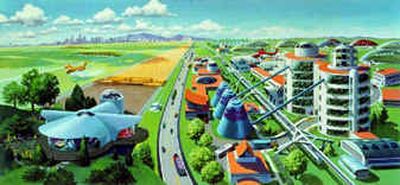‘Yesterday’s Tomorrows’ coming to Hayden

By the 21st century, one visionary predicted, our homes and everything in them would be made of plastic. Friendly housekeeper robots would be programmed to hose down the whole works once a week.
That was one 20th century vision of the future that hasn’t come to pass, so far at least. But that prediction and scores more that touch on nearly every aspect of Americans’ lives is detailed in an exhibition opening Sept. 25 at the Hayden Library.
Called “Yesterday’s Tomorrows,” it’s part of the Museum on Main Street Program, a partnership of the Smithsonian Institution and State Humanities Councils that brings Smithsonian exhibits and educational programs to rural America.
Within Idaho, the exhibit has already visited Pocatello, Rexburg and Hailey. It’s now in Burley and, when it leaves Hayden, will journey to Lewiston.
Yesterday’s Tomorrows consists of five, three-sided kiosks that use advertisements, toys, books, movie stills, World’s Fair memorabilia, and car and architectural designs to detail how Americans have envisioned the future.
Docents are being trained to answer questions and conduct tours, which are expected to last about 45 minutes.
The exhibition concentrates on the past 100 years in America, when visions of the future fluctuated between utopias characterized by breathtaking leaps of science and technology to urban chaos fraught with danger.
Themes include robots and automation, representations of the future in the popular media and by advertisers, the homes and communities of tomorrow, and transportation.
The project director for the Hayden exhibit, Karen Yother, provides an advance look as she describes its principal themes:
During the 19th century, she says, Americans thought that proper housing was essential to the future social and moral health of their families. Ideas about the home evolved, featuring modern architecture, mass production and automation.
Futuristic architecture actually appealed to few Americans, however, so home designs continued to reflect contemporary beliefs about family life, gender roles and social relations. And many of today’s homes feature exteriors, such as the Colonial and Craftsman styles, that hearken back to the past.
Post-World War II architects focused on creating homes with labor-saving devices that, in previous decades, had seemed truly visionary. Thus, the ideal home’s interior – a “machine for living” – was to be fitted with the latest gadgets.
In the past, Yother says, many people dreamed of having mechanical servants to lend helping hands. A frequent theme in fiction, movies and television was the vision of R2-D2-type androids as assistants and household helpers. But in reality, few human-looking robots have ever been created for those purposes.
We have robots, she says, that help us build cars, explore the seas and perform a variety of other useful tasks in science, medicine and space, but they bear little resemblance to the humanlike robots in yesterday’s visions of the future.
Even though the future exists only in our imaginations, it is eternally fascinating, and the communications media recognize its entertainment value by providing us predictions in movies, television, radio, magazines, comic books and advertising.
One of the exhibit’s kiosks features comic and paperback versions of H.G. Wells’ and Jules Verne’s prognostications, plus a toy ray gun, an outer space-themed lunchbox and Jetson family cartoon panels that were used in cellular phone advertisements.
Another exhibit theme is transportation.
Before the 1920s, Yother says, Americans envisioned transportation in mass-transit terms. However, the popularity of the automobile changed our futuristic visions. Cars became the designers’ and planners’ focus.
Thus, while Americans were still struggling through the Great Depression of the 1930s, automobile designers and engineers were envisioning cars that were symbols of the prosperity and the bright future that everyone hoped was just around the corner.
Then, as the population boom of the ‘50s and ‘60s brought more cars to our roads, automobile engineers and transportation planners began to concentrate their efforts on creating more efficient vehicles, faster modes of mass transit, and safer, “smarter” highways.
A kiosk reflects that progression, with photos of streamlined trains, sleek autos, cars that fly and programmed highways.
Visionaries of the early 20th century came up with community designs that also reflected Americans’ faith in progress and technology. The ideal community was envisioned in many ways, including one that melded 40,000 skyscrapers into a single structure that would house most North Americans.
After World War II, planned communities that promised seamless integration of domestic life with work became the focus of city planners. The exhibit notes that many of those communities never materialized, while others exist today.
Few visionaries addressed agriculture, but one forward thinker in 1970 predicted farms that would feature remote-controlled machines which would harvest crops, move grain into storage elevators and raise cattle. An artist’s rendering is on the Community of Tomorrow kiosk.
The Hayden Yesterday’s Tomorrows Program will remain at the library through Nov. 6. Special events programmed with it include a cartoon festival, robotics demonstration, antique evaluations, book discussions, a science fiction film festival, mini-displays and scavenger hunts. Lesson plans also are available.
Sponsors include Bechtel Industries, Mountain West Bank, Tom Addis Automotive Group, KXLY-TV, Parkwood Business Properties, Budget Storage, Super1 Foods of Hayden, KSAL Foundation, Friends of the KSA Libraries and TCBY Yogurt.
Additional information on the exhibition may be obtained from Yother at 772-5612, by visiting the library at 8385 N. Government Way or on the Web site www.ksalibraries.org.